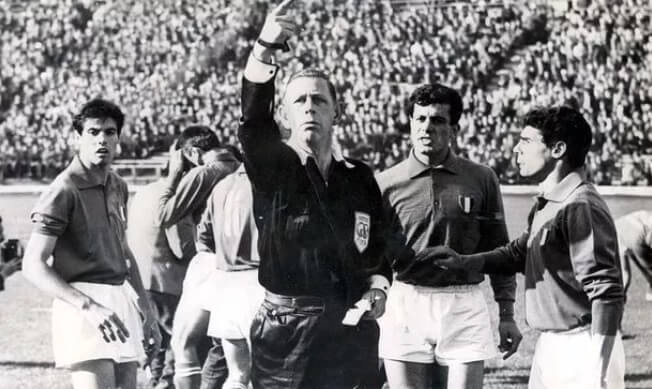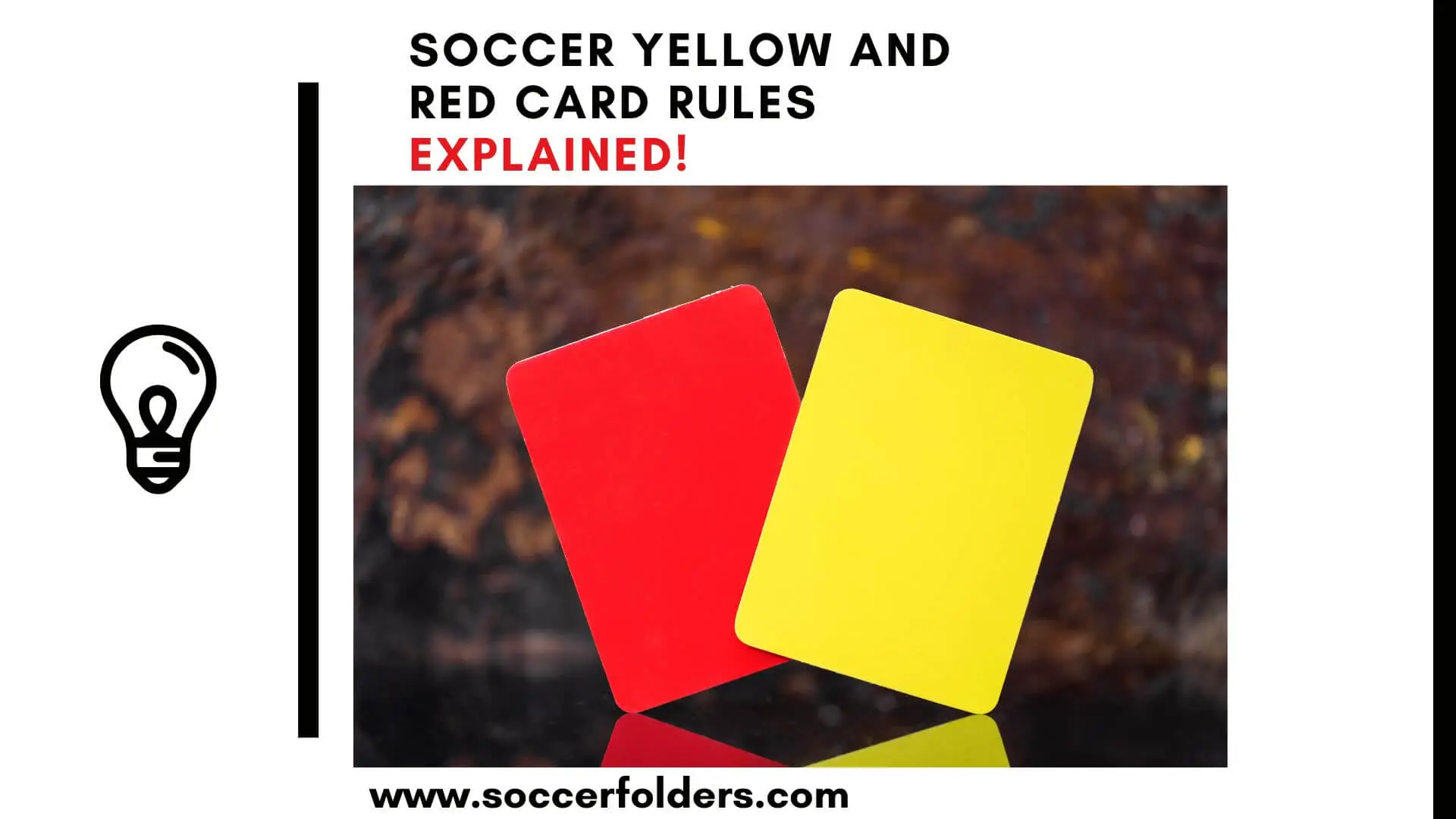Soccer is beloved worldwide, known as the “beautiful game” for its flow and athleticism. But there’s another side – tough tackles, fouls, and unsportsmanlike conduct can mar its beauty. That’s where Soccer yellow and red cards rules come in.
In this in-depth blog post, we will explore everything you need to know about yellow and red cards in soccer/football.
From the origins of the colored card system to what types of offenses warrant a caution or sending-off, we will cover all the nuances around these controversial refereeing tools.
Whether you are a lifelong fan of the sport or simply want to better understand the rules, this guide will give you an expert-level grasp of how and why yellow and red cards are used in the beautiful game.
Table Of Contents
- The Origins of Yellow and Red Cards
- What Offenses Warrant a Yellow Card?
- What Happens After a Yellow Card?
- When Does a Referee Give a Straight Red Card?
- Consequences of a Red Card
- Controversial Calls Involving Red Cards
- Does Player Intent Matter for Red Cards?
- Yellow and Red Cards for Non-Players
- Fines Instead of Cards for Retrospective Action
- Is Video Review Resulting in More Cards?
- The Future of Yellow and Red Card Enforcement
- Final Thoughts
The Origins of Yellow and Red Cards
Fifty years ago, during the 1970 World Cup Finals in Mexico, English official Ken Aston introduced the concept of yellow and red cards to football.
England had lost their World Champions title in the 1970 tournament to West Germany, but Aston’s innovation left a lasting impact.
Ken Aston, who served on the FIFA Referees Committee, devised the idea of using coloured cards to signify cautions and expulsions for players, making it clear to players, spectators, and reporters.
While waiting at a traffic light, he conceived the idea of using cards, inspired by traffic light colors. This innovation debuted in the 1970 World Cup and remains integral in soccer, transparently reflecting referees’ decisions.
The coloured card system added clarity for both players and spectators and helped referees communicate more effectively in front of huge crowds.
While a novelty at first, the yellow and red cards quickly became indispensable tools for referees across all levels of soccer. Today it’s impossible to imagine a high-level match without the flashing of a yellow or red card from the referee’s pocket.
What Offenses Warrant a Yellow Card?
Now that we’ve covered the history of the coloured card system, let’s explore in depth what types of actions will compel a referee to pull out that yellow slip of paper.
According to the Laws of the Game, there are seven major offenses that can result in a yellow card:
- Unsporting Behavior

This covers a wide range of transgressions including blatant tactical fouls, exaggerated injury falls, taunting, excessive celebration, provoking confrontation, and deliberate handling to stop play. Basically, any behaviour that is considered unethical or disrespectful of the game.
2. Dissent
Arguing with officials or exhibiting displeasure with their decisions in an aggressive or abusive way. Repeated questioning of calls may also warrant a caution.
3. Persistent Infringement
Committing multiple tactical fouls in a short period of time to break up play. This is meant to discourage deliberate “professional fouls.”
4. Delaying the Restart of Play
Slowing down restarts or impeding quick free kicks, throw-ins, etc. in order to waste time. Also includes kicking or carrying the ball away after a stoppage.
5. Failing to Respect the Required Distance
Not properly retreating 10 yards at free kicks or corner kicks. Continuing to encroach after a warning.
6. Entering the Field Without Permission
Players substituting must wait for the referee’s signal.
7. Deliberately Leaving the Field Without Permission
All substituting players must get approval from the referee.
As you can see, many yellow card offenses have to do with maintaining respect for the game and the referees who enforce the rules and control the flow of the match.
Clever players will often toe the line to gain small advantages through time-wasting, tactical fouls, or subtle dissent. It’s up to the referee to keep things under control.
Other Common Reasons for Yellow Cards
Beyond offenses spelt out in the Laws of the Game, there are other situations that will frequently elicit a yellow card:
- Reckless tackles: Late or overly aggressive challenges warranting a foul, but not excessive force. Often due to poor timing or lack of discipline.
- Handballs: Deliberately handling the ball to block it. A natural position during movement isn’t penalized.
- Charging the keeper: Rushing the goalkeeper who has possession of the ball in the penalty area.
- Shirt-pulling: Grabbing an opponent’s jersey is a common way to impede progress.
- Diving: Exaggerating contact or faking injury in hopes of winning a free kick or penalty.
- Kick-offs: Illegally moving on a kick-off before the ball is in play. Also encroaching over the center line.
- Illegal throw-ins: Failing to keep both feet on the ground or improperly releasing the ball behind the head.
- Dangerous play: Any action that risks injury, such as a high kick or elbow.
- Technical area violations: Only certain staff like coaches and doctors may occupy the team bench area.
As you can see, there are many ways for soccer players to attract the referee’s yellow card, whether intentionally bending the rules or simply accidentally letting emotions get the best of them.
What Happens After a Yellow Card?
A yellow card itself has very little immediate impact on the game – the player is simply warned and play continues.
However, cautions do get tracked and accumulated over the course of a match or tournament and can eventually lead to suspensions.
Here are some key implications of yellow cards:
- Second yellow = red: If a player receives two yellows in the same game, an indirect red card is shown for the second offense, resulting in their dismissal.
- World Cups: Accumulating two yellows over separate World Cup games causes a one-game suspension.
- European leagues: Varies by league but often 5 accumulative yellows equals a one-game ban. 10 over a season can trigger a multiple-game suspension.
- Goalkeepers: If a goalkeeper is sent off for a second yellow card offense, they can be replaced by a substitute.
So while going “in the book” for a first yellow card isn’t a massive worry, players must be cautious about racking up multiple cautions during a single match or over a series of games.
Otherwise, their teams may sorely miss them in future games due to suspension. Managers will often rest players nearing suspension limits.
When Does a Referee Give a Straight Red Card?

Compared to the yellow card’s multitude of minor offenses, the red card is reserved for only the most egregious fouls and misconduct. There are two main cases that will result in a player being directly sent off:
- Serious foul play: A tackle or challenge that endangers the safety of an opponent. Could be due to excessive force, brutality, or intent to harm.
- Violent conduct: Aggressive actions such as punching, kicking, headbutting, biting, or spitting.
Additionally, a substitute or substituted player can be shown red for violent conduct on the pitch or outside its boundaries.
Beyond dangerous tackles and violent acts, a red card may also be shown for:
- Denying a goalscoring opportunity: Handling the ball or fouling a player moving towards goal with only the keeper ahead. This applies even if attempt to play the ball.
- Spitting at an opponent or any other person
- Serious foul play: Tackling that endangers safety even if the ball is won. Also “tunnelling” where a player raises their feet in a tackle, risking injury.
- Foul or abusive language: Extremely offensive, insulting or abusive verbal misconduct.
- Second yellow card offense
- Handling deliberate: Deliberately touching the ball with hand/arm to stop an attack or attempt to score.
Essentially, a straight red card is meant for reckless, purposeful fouls with no regard for player safety or extreme misconduct. These send-offs are always followed by at least a one-match suspension.
Consequences of a Red Card
A red card is the ultimate punishment for a soccer player, with immediate and lingering consequences:
- Dismissal: The player must immediately leave the pitch and go to the locker room. They cannot be replaced by a substitute, forcing their team to play down a man.
- Suspension: Minimum one-game ban according to FIFA’s rules. Many league and tournament rules dictate longer suspensions of 3+ games.
- Abandonment: If a goalkeeper is red-carded and there’s no other goalie on the bench, an outfield player must replace them in goal. If a team has no subs left and no goalie, the match is abandoned.
- Fine: Many leagues impose fines on players for straight red cards in addition to match bans. Excessive red cards may result in larger fines.
- Reputation: Being perceived as a “dirty” player can hurt the chances of being scouted or renewing contracts down the line.
In short, red cards can massively hurt both the player and the team’s short-term and long-term fortunes.
Coaches drill into players the importance of keeping cool heads to avoid destroying their team’s chances in the current game and beyond.
Controversial Calls Involving Red Cards
While straight red card offenses should be crystal clear, sometimes controversial calls leave players and fans fuming at the perceived injustice:
- Questionable fouls: Despite VAR reviews, rash challenge red cards are still subjective depending on referees. Close calls go against the defense.
- Double punishment: A penalty kick plus a red card for denying a goalscoring opportunity is seen by some as excessively harsh.
- Mistaken identity: Referees occasionally send off the wrong player in cases of group confrontation and dissent.
- Making an example: Some allege lesser-known players are dismissed for fouls that would only warrant yellow cards for superstars.
- Outside circumstances: Red cards have been given for off-the-ball incidents like headbutting during corner kicks that referees miss.
==>> By the way, you should also read my article about soccer corner kick rules here.
Even with video review, soccer is arguably the most difficult sport for officials to govern perfectly. Controversial judgment calls are part of what makes the beautiful game equally maddening at times!
Does Player Intent Matter for Red Cards?

One nuanced debate around red cards is whether a player’s intent should factor into the decision to send them off or just the outcome of their actions.
There are two perspectives on this:
Strict liability view: It doesn’t matter if the player meant it or not. Reckless play that endangers others must be harshly punished to protect player safety.
Mitigating factors view: The referee should consider whether the player was making fair play for the ball and the challenge just got out of control due to pace and momentum. Punishment should fit the crime.
Governing bodies seem to lean towards strict liability with fewer allowances for accidental collisions.
However, intent can influence disciplinary panel decisions on suspension lengths after the fact. But in the heat of the moment, the referee usually reaches for red regardless of motives.
Yellow and Red Cards for Non-Players
We’ve covered the rules on cautions and send-offs for players at length. But did you know managers, coaches and even substitute players can end up in the referee’s book?
Here are some reasons non-playing personnel may receive cards during games:
- Dissent: Managers or staff excessively shout at or argue with officials. Continual yelling after a warning.
- Physical contact: Touching or aggressively confronting referees, which may warrant an immediate red card.
- Leaving the technical area: The manager repeatedly leaves the designated bench and technical area to shout instructions or protest calls.
- Deliberately throwing/kicking objects: Managers angrily toss items like bottles from the technical area.
- Entering the pitch: Physios or coaches going on the field without the referee’s permission both warrant yellow cards.
- Provoking spectators: Incitement of crowds against referees by a manager or player.
So while they won’t be running laps or risking suspension, it’s possible for both players and staff to see their name written into the referee’s notebook over 90 minutes.
Fines Instead of Cards for Retrospective Action
Sometimes punishment comes after the final whistle through retrospective action by league officials:
- Simulation: Fining players for obviously feigning injuries or diving. Yellow cards can’t be given retroactively.
- Violent conduct missed: Suspending players for clear red card violent conduct the referee missed spotting live.
- Mass confrontations: Fining both teams for group dissent and swarming the referee post-match.
Leagues want to stamp out unsportsmanlike play even when refs don’t wield the cards in real time. Harsh fines make teams responsible for their players’ conduct.
Is Video Review Resulting in More Cards?
The increasing use of video assistant referee (VAR) reviews over the past 5 years has fundamentally changed refereeing and the application of cards in the modern game.
By reviewing plays on the video screens on the sideline, referees can retrospectively give out yellow and red cards that previously would have gone unpunished in the rapid flow of a soccer match.
Proponents believe VAR reduces referee errors and catches fouls that go unnoticed at full speed. However, critics argue that slow-motion replays make innocuous collisions seem intentional and lead referees to excessively reach for red cards.
Statistics on cards post-VAR introduction are mixed:
- 2018 World Cup: Set a record high with 28 red cards dished out.
- Premier League: Red cards only slightly increased in the first 2 seasons with VAR compared to prior years.
- Bundesliga: Overall cards given increased significantly across the board after implementing video review.
So while video replay aims to produce more accurate calls, it may also subtly shift refereeing to become more punitive across the board. What is certain is that VAR has irrevocably changed how the cards are utilized at the top levels of the game.
The Future of Yellow and Red Card Enforcement
From its origins at the 1966 World Cup to the modern VAR era, yellow and red cards remain at the center of maintaining fair play and discipline.
While the basics have held firm for decades, there are innovations on the horizon:
- Temporary dismissals: Some lower leagues are trialling 10 or 15-minute time-limited red cards before a player can return, similar to ice hockey penalties.
- Challenge system: Major League Soccer allows coaches one challenge per match to fight red cards via video review.
- Automated decisions: FIFA is experimenting with semi-automated offside calls and could expand to automatic red card issuance based on strict liability rules.
- Punishments per position: Some analysts argue goalkeepers should face greater suspensions than field players for red card fouls due to their outsized influence.
- In-game fines: Concepts requiring carded players to leave money in a Dropbox before returning have been floated to increase on-field consequences.
While not universally endorsed, these outside-the-box ideas demonstrate the cards may still evolve along with the sport itself. But for now, the iconic yellow and red cards remain the timeless tools referees use to officiate the beautiful game we all love.
Final Thoughts
The focus of this article primarily revolved around the details of soccer yellow and red card rules, shedding light on their critical role within the game.
I genuinely hope that you’ve found substantial value in delving into this subject and that the insights shared here contribute to a deeper understanding of the sport’s dynamics and regulations.
You might also like these articles:

